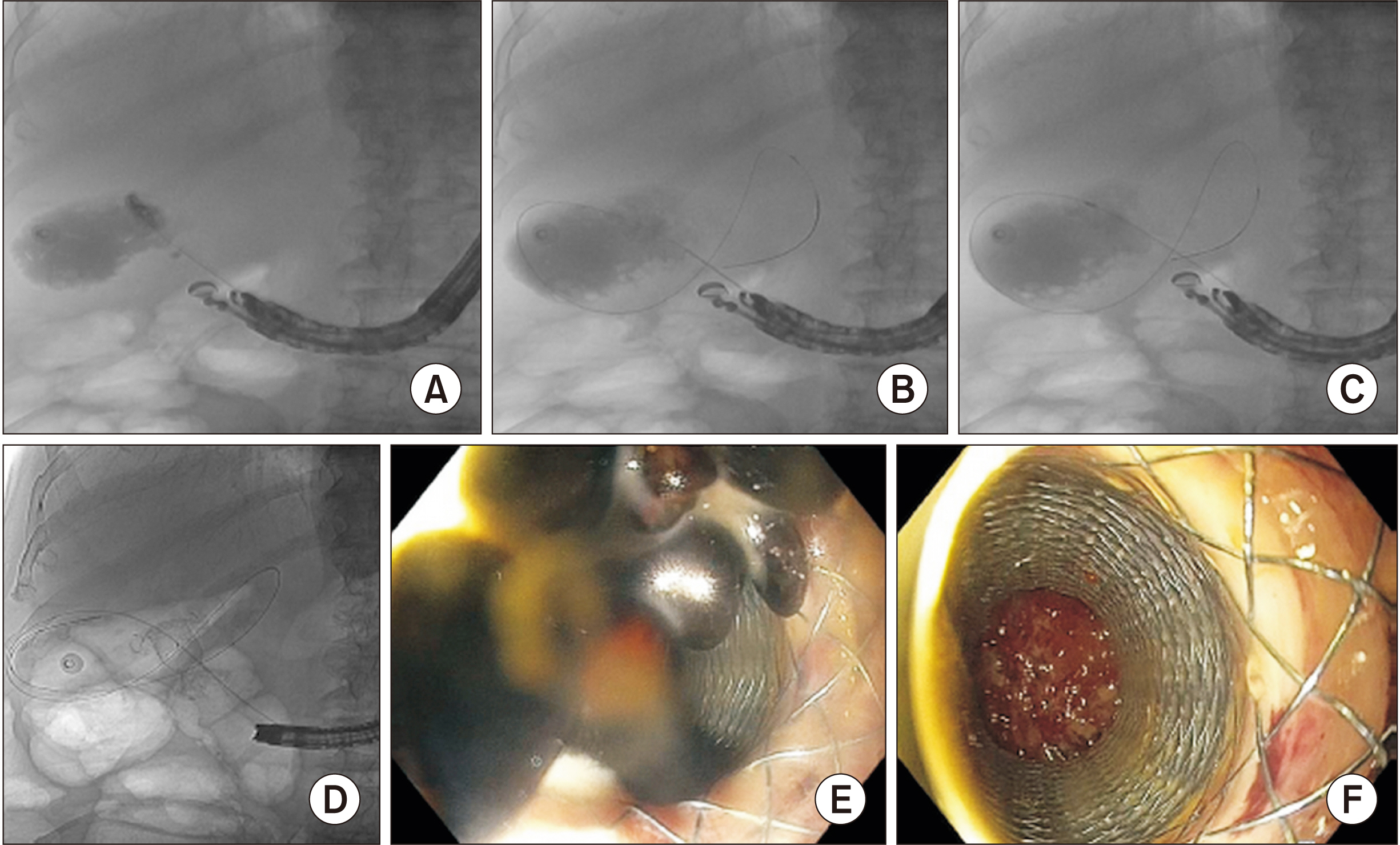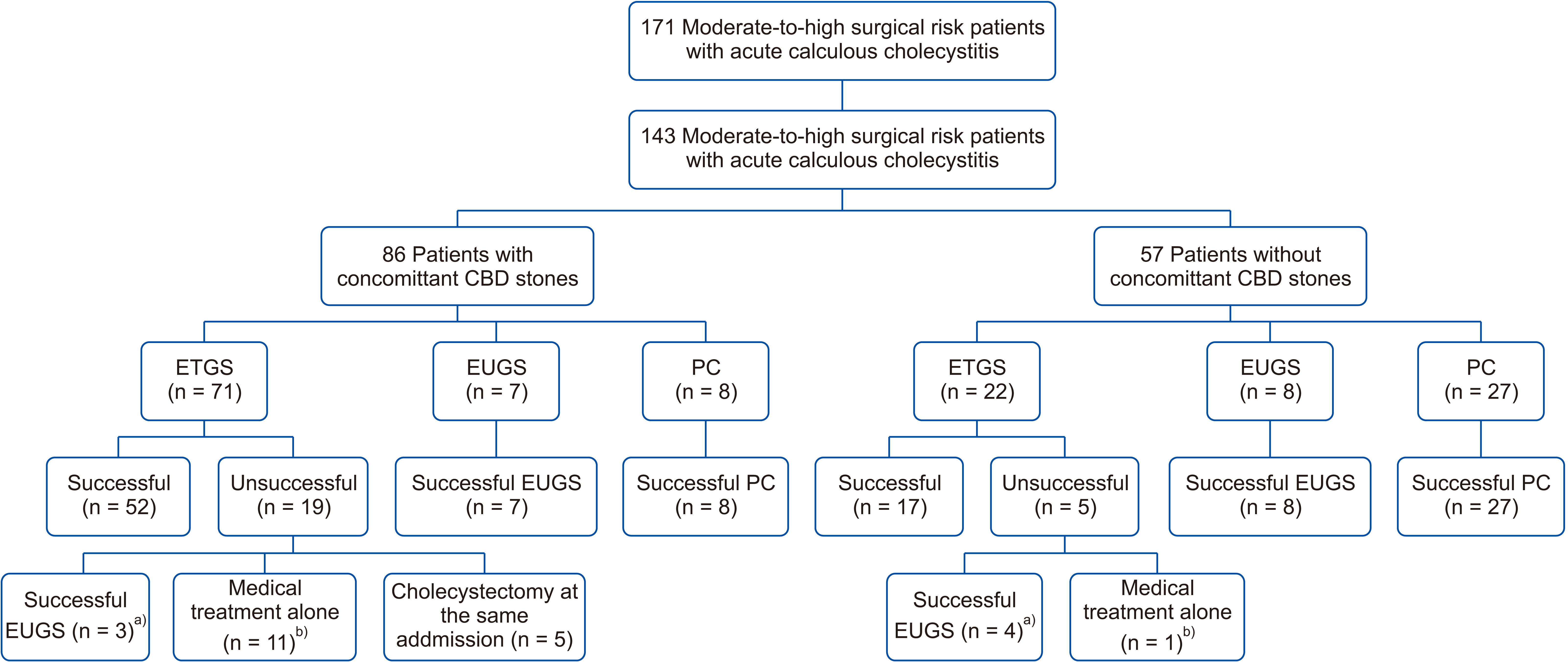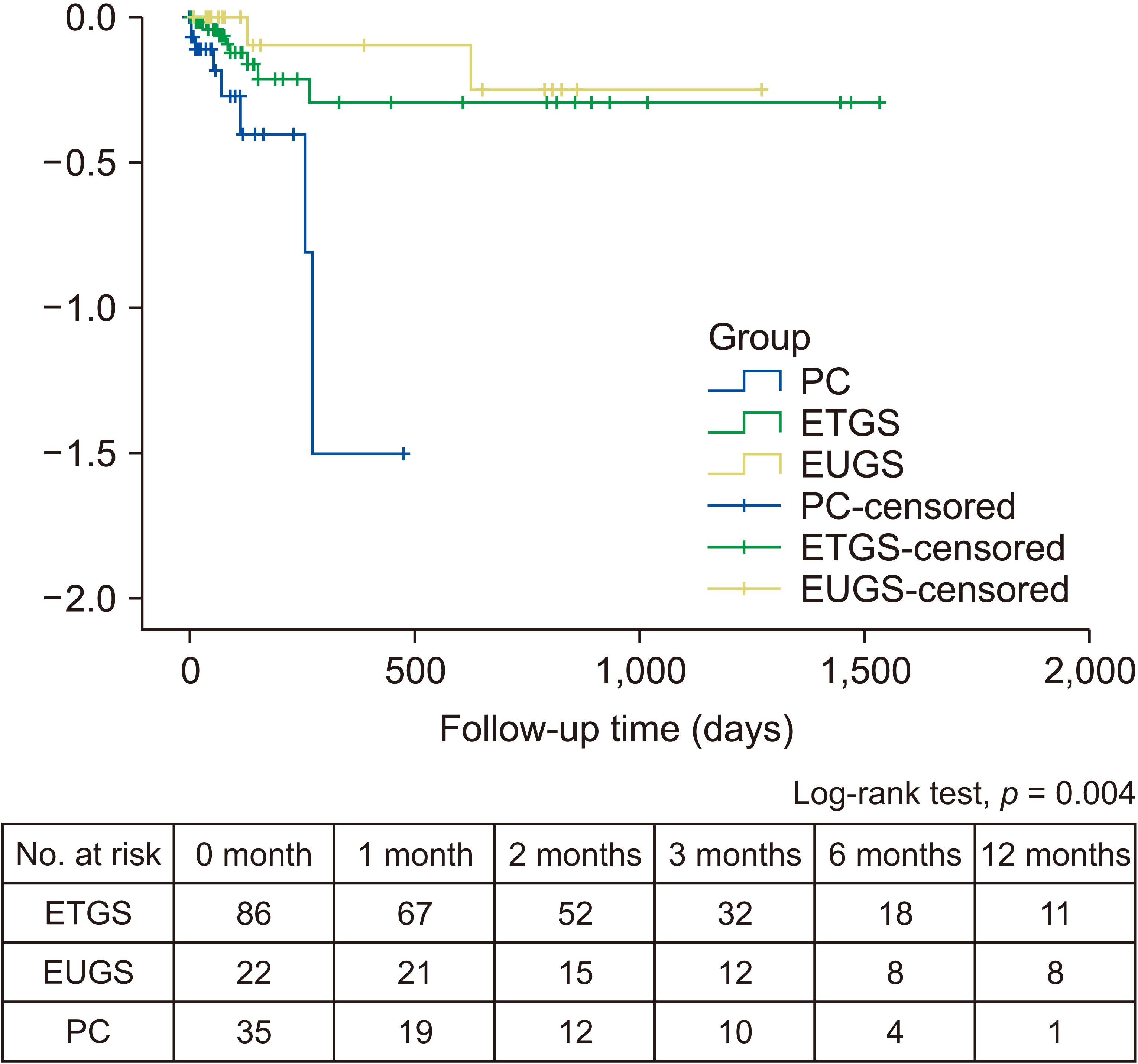Ann Hepatobiliary Pancreat Surg.
2022 Feb;26(1):104-112. 10.14701/ahbps.21-098.
Ultimate outcomes of three modalities for non-surgical gallbladder drainage in acute cholecystitis with or without concomitant common bile duct stones
- Affiliations
-
- 1Division of Gastroenterology, Department of Medicine, Faculty of Medicine, Chulalongkorn University and King Chulalongkorn Memorial Hospital, Thai Red Cross, Bangkok, Thailand
- 2Center of Excellence for Innovation and Endoscopy in Gastrointestinal Oncology, Faculty of Medicine, Chulalongkorn University, Bangkok, Thailand
- 3Department of Medicine, Buddhachinaraj Hospital, Phitsanulok, Thailand
- 4Department of Anatomy, Faculty of Medicine, Chulalongkorn University, Bangkok, Thailand
- KMID: 2526839
- DOI: http://doi.org/10.14701/ahbps.21-098
Abstract
- Backgrounds/Aims
In moderate and high-surgical risk patients with acute cholecystitis, studies comparing percutaneous cholecystostomy (PC) vs. endoscopic transpapillary gallbladder stenting (ETGS) vs. endoscopic ultrasound-guided transmural gallbladder stenting (EUGS) are limited. Thus, the aim of this study was to compare efficacy and recurrence of cholecystitis after PC, ETGS, or EUGS during follow-up.
Methods
We reviewed 143 moderate and high-surgical risk patients with acute cholecystitis with or without concomitant common bile duct stones who underwent PC, ETGS, or EUGS at our hospital. Technical success rate (TSR), clinical success rate (CSR), and recurrence were compared.
Results
TSR in PC or EUGS group was higher than that in the ETGS group for those with concomitant common bile duct stones (100% vs. 100% vs. 73.2%; p = 0.07) and for those without concomitant common bile duct stones (100% vs. 100% vs. 77.3%; p < 0.001). CSR in ETGS or EUGS group was higher than that in the PC group for those with concomitant common bile duct stones (96.2% vs. 100% vs. 87.5%; p = 0.41) and for those without concomitant common bile duct stones (94.1% vs. 100% vs. 63.0%; p = 0.006). Using Kaplan–Meier analysis, the overall recurrent risk was the highest in the PC group (p = 0.004).
Conclusions
In moderate and high-surgical risk patients with acute cholecystitis, EUGS provides significantly higher CSR with comparable TSR to PC. Thus, ETGS should be the first choice in those with concomitant common bile duct stones. Among the three patient groups, those who received PC had the highest rate of recurrence.
Keyword
Figure
Reference
-
1. Iino C, Shimoyama T, Igarashi T, Aihara T, Ishii K, Sakamoto J, et al. 2018; Comparable efficacy of endoscopic transpapillary gallbladder drainage and percutaneous transhepatic gallbladder drainage in acute cholecystitis. Endosc Int Open. 6:E594–E601. DOI: 10.1055/s-0044-102091. PMID: 29744378. PMCID: PMC5940465.
Article2. Okamoto K, Suzuki K, Takada T, Strasberg SM, Asbun HJ, Endo I, et al. Tokyo Guidelines 2018: flowchart for the management of acute cholecystitis. J Hepatobiliary Pancreat Sci. 2018; 25:55–72. DOI: 10.1002/jhbp.516. PMID: 29045062.3. Boules M, Haskins IN, Farias-Kovac M, Guerron AD, Schechtman D, Samotowka M, et al. 2017; What is the fate of the cholecystostomy tube following percutaneous cholecystostomy? Surg Endosc. 31:1707–1712. DOI: 10.1007/s00464-016-5161-x. PMID: 27519595.
Article4. Siddiqui A, Kunda R, Tyberg A, Arain MA, Noor A, Mumtaz T, et al. 2019; Three-way comparative study of endoscopic ultrasound-guided transmural gallbladder drainage using lumen-apposing metal stents versus endoscopic transpapillary drainage versus percutaneous cholecystostomy for gallbladder drainage in high-risk surgical patients with acute cholecystitis: clinical outcomes and success in an International, Multicenter Study. Surg Endosc. 33:1260–1270. DOI: 10.1007/s00464-018-6406-7. PMID: 30209610.
Article5. Higa JT, Sahar N, Kozarek RA, La Selva D, Larsen MC, Gan SI, et al. 2019; EUS-guided gallbladder drainage with a lumen-apposing metal stent versus endoscopic transpapillary gallbladder drainage for the treatment of acute cholecystitis (with videos). Gastrointest Endosc. 90:483–492. DOI: 10.1016/j.gie.2019.04.238. PMID: 31054909.
Article6. Itoi T, Coelho-Prabhu N, Baron TH. 2010; Endoscopic gallbladder drainage for management of acute cholecystitis. Gastrointest Endosc. 71:1038–1045. DOI: 10.1016/j.gie.2010.01.026. PMID: 20438890.
Article7. Oh D, Song TJ, Cho DH, Park DH, Seo DW, Lee SK, et al. 2019; EUS-guided cholecystostomy versus endoscopic transpapillary cholecystostomy for acute cholecystitis in high-risk surgical patients. Gastrointest Endosc. 89:289–298. DOI: 10.1016/j.gie.2018.08.052. PMID: 30213575.
Article8. Irani S, Ngamruengphong S, Teoh A, Will U, Nieto J, Abu Dayyeh BK, et al. 2017; Similar efficacies of endoscopic ultrasound gallbladder drainage with a lumen-apposing metal stent versus percutaneous transhepatic gallbladder drainage for acute cholecystitis. Clin Gastroenterol Hepatol. 15:738–745. DOI: 10.1016/j.cgh.2016.12.021. PMID: 28043931.
Article9. Anderloni A, Buda A, Vieceli F, Khashab MA, Hassan C, Repici A. 2016; Endoscopic ultrasound-guided transmural stenting for gallbladder drainage in high-risk patients with acute cholecystitis: a systematic review and pooled analysis. Surg Endosc. 30:5200–5208. DOI: 10.1007/s00464-016-4894-x. PMID: 27059975.
Article10. Salameh H, DiMaio CJ. 2019; Endoscopic retrograde cholangiopancreatography and endoscopic ultrasound-guided gallbladder drainage. Gastrointest Endosc Clin N Am. 29:293–310. DOI: 10.1016/j.giec.2018.12.002. PMID: 30846154.
Article11. Johlin FC Jr, Neil GA. 1993; Drainage of the gallbladder in patients with acute acalculous cholecystitis by transpapillary endoscopic cholecystotomy. Gastrointest Endosc. 39:645–651. DOI: 10.1016/S0016-5107(93)70216-3. PMID: 8224686.
Article12. Ridtitid W, Piyachaturawat P, Teeratorn N, Angsuwatcharakon P, Kongkam P, Rerknimitr R. 2020; Single-operator peroral cholangioscopy cystic duct cannulation for transpapillary gallbladder stent placement in patients with acute cholecystitis at moderate to high surgical risk (with videos). Gastrointest Endosc. 92:634–644. DOI: 10.1016/j.gie.2020.03.3866. PMID: 32330504.
Article13. McCarthy ST, Tujios S, Fontana RJ, Rahnama-Moghadam S, Elmunzer BJ, Kwon RS, et al. 2015; Endoscopic transpapillary gallbladder stent placement is safe and effective in high-risk patients without cirrhosis. Dig Dis Sci. 60:2516–2522. DOI: 10.1007/s10620-014-3371-4. PMID: 25287001.
Article14. Maekawa S, Nomura R, Murase T, Ann Y, Oeholm M, Harada M. 2013; Endoscopic gallbladder stenting for acute cholecystitis: a retrospective study of 46 elderly patients aged 65 years or older. BMC Gastroenterol. 13:65. DOI: 10.1186/1471-230X-13-65. PMID: 23586815. PMCID: PMC3675408.15. Lee TH, Park DH, Lee SS, Seo DW, Park SH, Lee SK, et al. 2011; Outcomes of endoscopic transpapillary gallbladder stenting for symptomatic gallbladder diseases: a multicenter prospective follow-up study. Endoscopy. 43:702–708. DOI: 10.1055/s-0030-1256226. PMID: 21425042.
Article16. Kjaer DW, Kruse A, Funch-Jensen P. 2007; Endoscopic gallbladder drainage of patients with acute cholecystitis. Endoscopy. 39:304–308. DOI: 10.1055/s-2007-966335. PMID: 17427067.
Article17. Irani S, Baron TH, Grimm IS, Khashab MA. 2015; EUS-guided gallbladder drainage with a lumen-apposing metal stent (with video). Gastrointest Endosc. 82:1110–1115. DOI: 10.1016/j.gie.2015.05.045. PMID: 26142558.
Article18. Khan MA, Atiq O, Kubiliun N, Ali B, Kamal F, Nollan R, et al. 2017; Efficacy and safety of endoscopic gallbladder drainage in acute cholecystitis: is it better than percutaneous gallbladder drainage? Gastrointest Endosc. 85:76–87.e3. DOI: 10.1016/j.gie.2016.06.032. PMID: 27343412.
Article19. Mohan BP, Asokkumar R, Shakhatreh M, Garg R, Ponnada S, Navaneethan U, et al. 2019; Adverse events with lumen-apposing metal stents in endoscopic gallbladder drainage: a systematic review and meta-analysis. Endosc Ultrasound. 8:241–248. DOI: 10.4103/eus.eus_63_18. PMID: 31115387. PMCID: PMC6714485.
Article20. Mohan BP, Khan SR, Trakroo S, Ponnada S, Jayaraj M, Asokkumar R, et al. 2020; Endoscopic ultrasound-guided gallbladder drainage, transpapillary drainage, or percutaneous drainage in high risk acute cholecystitis patients: a systematic review and comparative meta-analysis. Endoscopy. 52:96–106. DOI: 10.1055/a-1020-3932. PMID: 31645067.
Article21. Yokoe M, Hata J, Takada T, Strasberg SM, Asbun HJ, Wakabayashi G, et al. Tokyo Guidelines 2018: diagnostic criteria and severity grading of acute cholecystitis (with videos). J Hepatobiliary Pancreat Sci. 2018; 25:41–54. DOI: 10.1002/jhbp.515. PMID: 29032636.22. Buxbaum JL, Abbas Fehmi SM, Sultan S, Fishman DS, Qumseya BJ, Cortessis VK, et al. 2019; ASGE guideline on the role of endoscopy in the evaluation and management of choledocholithiasis. Gastrointest Endosc. 89:1075–1105.e15. DOI: 10.1016/j.gie.2018.10.001. PMID: 30979521. PMCID: PMC8594622.
Article23. Rerknimitr R, Pham KC. 2020; Practical approaches for high-risk surgical patients with acute cholecystitis: the percutaneous approach versus endoscopic alternatives. Clin Endosc. 53:678–685. DOI: 10.5946/ce.2019.186. PMID: 31914724. PMCID: PMC7719420.
Article24. Yoshida M, Naitoh I, Hayashi K, Jinno N, Hori Y, Natsume M, et al. 2021; Four-step classification of endoscopic transpapillary gallbladder drainage and the practical efficacy of cholangioscopic assistance. Gut Liver. 15:476–485. DOI: 10.5009/gnl20238. PMID: 33402544. PMCID: PMC8129659.
Article25. Tomimaru Y, Fukuchi N, Yokoyama S, Mori T, Tanemura M, Sakai K, et al. 2020; Optimal timing of laparoscopic cholecystectomy after gallbladder drainage for acute cholecystitis: a multi-institutional retrospective study. J Hepatobiliary Pancreat Sci. 27:451–460. DOI: 10.1002/jhbp.768. PMID: 32460406.
Article26. Saumoy M, Tyberg A, Brown E, Eachempati SR, Lieberman M, Afaneh C, et al. 2019; Successful cholecystectomy after endoscopic ultrasound gallbladder drainage compared with percutaneous cholecystostomy, can it be done? J Clin Gastroenterol. 53:231–235. DOI: 10.1097/MCG.0000000000001036. PMID: 29697498.
Article27. Teoh AY, Perez-Miranda M, Kunda R, Lee SS, Irani S, Yeaton P, et al. 2019; Outcomes of an international multicenter registry on EUS-guided gallbladder drainage in patients at high risk for cholecystectomy. Endosc Int Open. 7:E964–E973. DOI: 10.1055/a-0915-2098. PMID: 31367676. PMCID: PMC6656552.
Article
- Full Text Links
- Actions
-
Cited
- CITED
-
- Close
- Share
- Similar articles
-
- A case of limy bile accompanied with gallbladder stones and common bile duct stone
- Percutaneous cholecystostomy
- Bile Duct Stenosis & Intrahepatic Stones after a Transcather Hepatic Arterial Embolization: A case report
- Endoscopic Management of Acute Cholecystitis and Cholangitis Caused by Limy Bile
- The Endoscopic Management of Common Bile Duct Stones






